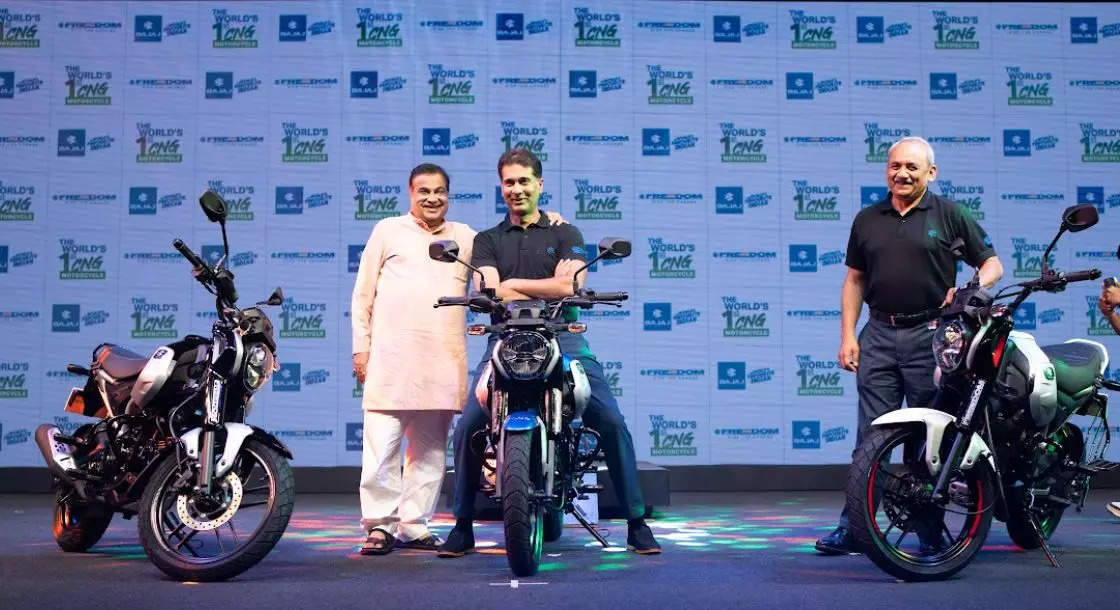
With the recent launch of its Freedom 125 in Pune, Bajaj Auto has thrown down the gauntlet in the commuter motorcycle space. By being the first of its kind to offer compressed natural gas (CNG) as a fuel option, the new offering has the potential to be a massive disruptor in the 100cc-125cc motorcycle segment. The total number of commuter bikes sold each month is around 650,000 units of which Bajaj Auto’s share is 150,000 units.
Hero MotoCorp is the leader in the 100cc space while the 125cc category is the bastion of Honda Motorcycle & Scooter India. Bajaj Auto is the No 2 player here and the Freedom 125 will strive to bridge the gap with the market leader. “We have a real opportunity and are at the right place and time,” Rajiv Bajaj, Managing Director, said at the press conference.
From his point of view, the new motorcycle is a game-changer in many aspects. “You need freedom of thought, expression, speech and action to determine your destiny. The spirit of freedom is integral to every Indian…freedom from petrol prices, freedom from charging concerns, from boring designs of commuter motorcycles, freedom from uncomfortable rides and freedom from unsustainable solutions to support sustainable technologies,” Bajaj elaborated.

Differentiator strategy
The motorcycle is also in sync with the company’s strategy of differentiation which has been its mantra since the time the Pulsar was launched over two decades ago. It blazed a new trail in sports motorcycles and the company then extended this differentiator formula to the Discover 125 which was launched in 2004.Now with Freedom, Bajaj Auto will be hoping that it can play the role of a disruptor in the commuter space. Volumes will be modest to begin with at about 10,000 units each month and then growing rapidly to 40,000 units by the end of this fiscal.
The bike will be launched in Maharashtra and Gujarat first before it makes its way into other parts of the country which have enough CNG outlets. After all, its availability is critical for any customer to contemplate buying the Freedom. Today, there are over 6,000 retail outlets for CNG spread across 335 cities and towns. It is a much healthier number than the time it was first made mandatory in New Delhi nearly 25 years ago and long, serpentine queues were the order of the day.
The Bajaj Auto MD recalled the time when he received “startling news” one afternoon in the office that a group of auto rickshaw drivers had smashed a CNG retail outlet. They were upset about the fact that there was just one CNG station catering to an army of auto rickshaws
whose drivers had been waiting for 10-12 hours to fill up gas. The pent up frustration spilt over into massive levels of anger which led to the outlet virtually being destroyed.
Supporting ecosystem
“Customers expect a holistic brand experience and the supporting ecosystem is as vital. It is not enough making a new product alone,” reiterated Bajaj. To that extent, the Freedom will have access to more CNG outlets today, compared to the dismal scenario at the turn of the century, where policymakers erred in putting the cart before the horse. The zeal for clean air solutions preceded any effort to sit and work on a plan first in creating the necessary infrastructure.
Over the next 3-4 months, the field staff at Bajaj Auto will be gauging customer response to the Freedom across Gujarat and Maharashtra. All the feedback will be carefully recorded and used as important inputs to plan the next course of action. This was pretty much the case with the Chetak electric scooter which was launched initially in Pune and Bengaluru before it set out to spread its footprint across other parts of the country.
Industry experts ETAuto spoke to said there was no question that the Freedom 125 was a triumph of innovation and a feather in Bajaj Auto’s cap. “The fact that it is the world’s first CNG motorcycle is no small feat and this is a matter of great pride to India,” said a former CEO of a two-wheeler company.
Will this be good enough for customers to make a beeline for the Freedom? Another official said the biggest deterrent with CNG was the long queues in fuel stations, of which a bulk comprise three-wheelers. “Will a Freedom owner have the time, inclination and patience to sweat it out for half an hour to get his bike filled? I am not sure if he will exactly be jumping for joy at the prospects,” he added.
Easy access
According to a CEO of a two-wheeler finance company, most CNG outlets are located in cities whereas the real markets for commuter bikes lie in rural India. “Residents of small towns will be ready to buy and ride the Freedom given its low operating costs but they also need to be assured of easy access to CNG,” he said.
Representatives of oil marketing companies, who were also present at the press conference, were however confident that CNG infrastructure would be ramped up quickly in the coming years. The likes of GAIL, Indraprastha Gas, Mahanagar Gas, IOC, BPCL and HPCL along with Reliance BP Mobility, Adani Total Gas, Nayara Energy etc will need to go the extra mile to grow the CNG network.
As industry observers say, this exercise is still worth the while silly because “it would be suicidal to put all eggs in the electric basket”. While this was seen as the best solution at one point in time especially in markets like India and Europe, there is now a growing realization that other clean fuel options like CNG need to be examined too.
The Freedom 125 is now ahead of the curve in terms of having the first mover advantage. As the network for CNG grows, its penetration will increase correspondingly once early adopters also begin spreading the world. The transition is also happening quickly in the automobile segment where companies like Tata Motors, the market leader in electric, are now going all out with CNG too.
Tata Motors experience
Shailesh Chandra, Managing Director of Tata Motors Passenger Vehicles and Tata Passenger Electric Mobility, had told this writer in an interview that this decade would see an increased focus on CNG. The idea was to offer a “value proposition” in the backdrop of rising petrol prices accompanied by the fact that there were plans to increase its spread across the country.
According to Chandra, CNG could replace diesel in the lower segments — use of diesel had, in any case, come down in passenger cars especially in hatchbacks and sedans post Bharat Stage VI. It continues to be relevant in bigger cars and SUVs where customers seek more power.
In the mid-term, continued Chandra, engine capacities of less than 1.5 litres would move towards petrol/CNG while those in excess (of 1.5 litres) would still have diesel. In the long-term, though, diesel would come under pressure due to stringent emission norms like Euro 7 which would make their way into India.
The Tata Motors experience would have also convinced Bajaj Auto that the Freedom 125 would gradually grow in acceptance both among personal users and the gig economy where cost of ownership is an important factor. Once CNG supplies increase and queues reduce at fuel stations, bike taxis like Rapido would like to try their hands with something like the Freedom 125. Affordability is all-important in the B2B space and here is where the likes of Swiggy, Zomato and Zepto would not mind experimenting with the Bajaj offering.















